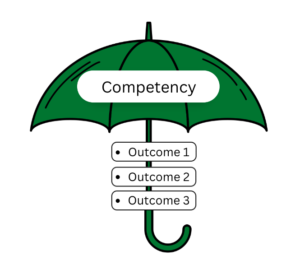Defining Competencies and Outcomes

Summary: Improve your course clarity with competencies and outcomes. Learn how to break down complex skills into measurable parts for better student understanding and success.
Date of publishing: January 16, 2023
Defining Competencies and Outcomes
Although there is no widely accepted distinction between a competency and an outcome, there is sufficient commonality for the following working definition to be used to improve the structure and clarity of courses and programs.
- A competency is an overarching capability the learner can do. Examples include critical thinking, problem solving, effective communication, design functions, or physical performative skills. Since a competency is generally too complex to measure on its own, it must be broken down into its core, and often interconnected, measurable outcomes (sometimes called objectives).
- Learning outcomes, then, are the core measurable components that together make up the competency.
A competency is more than silos of outcomes. The complexity of a competency exists through the intertwining of the outcomes.
Let’s look at the example of driving.
Competency: The ability to operate a motor vehicle safely and efficiently.
Outcomes:
-
-
- Knowledge of and adherence to traffic laws.
- Maintain proper vehicle handling and control.
- The ability to make quick and effective decisions in various driving situations.
- Assess potential hazards on the road and take appropriate action to avoid or mitigate them.
-
To meet the complexity of driving, it is not sufficient to consider adherence to traffic laws in isolation of making decisions in various driving situations. The outcomes are connected to each other and the larger competency.
See further examples at the end of this post.
A question I am often asked is:
“How many competencies and outcomes do I need in a course?”
Once again, there is no widely agreed upon number. However, I recommend using the following guideline for a 3 credit-unit course that occurs over three months or 12 full weeks.
If each of your competencies has an equitable focus, it is reasonable to have three competencies per course and three outcomes per competency.
Variations might include, one competency and nine outcomes or two competencies with three outcomes for the first competency and 5 outcomes for the second competency.
This generalization will vary, depending on the size and scope of each competency. Keep the overall course outcomes limited to no more than 10 (less is better) so students have time to practice, get feedback, and improve throughout the course.
If you find you have too many competencies and/or outcomes, consider the following questions:
- What are the overarching “themes” of the course?
- Am I including content that is “nice to know” but not “essential to know”?
- Does the course allow time for the student to gain feedback and apply their knowledge for deep understanding? If not, refer to the first bullet point.
- Is it more important for me to cover a broad amount of content or that a student understands limited content more deeply? Deep understanding will take more time. Refer back to the first bullet point.
- Do you have outcomes that can be combined for a more targeted focus?
If you would like assistance articulating the competencies and outcomes in your courses, please contact the Gwenna Moss Centre for Teaching and Learning for a one-on-one consultation with an educational development specialists.
Competency and Outcome Examples
Humanities Example
Understand the foundations of Canadian Law.
Outcomes:
- Evaluate the purpose and function of law in societies.
- Analyze how and why laws change over time.
- Assess the importance of the Canadian Charter of Rights and Freedoms.
Research Example
Calculus Example
Demonstrate understanding of differentiation based on slope as a rate of change.
Outcomes:
- Interpret and explain the difference between average rate of change and instantaneous rate of change.
- Develop, explain, and apply strategies for determining the slope of the tangent line at a particular point by finding the slopes of secant lines.
- Develop, explain, and apply the process of implicit differentiation.
- Critique the statement, “If a function is continuous, then it is differentiable.”
Full Course Sample
 Competency #1:
Competency #1:Application of Learning Theories: Apply online learning theories to design effective and engaging course content and instruction
Outcomes for Competency #1:
- Justify how the learning theory used to design your module meets the needs of the learners (e.g., layout, content, instruction, assessment).
- Justify why you did not choose the next best learning theory used in your module design.
Competency #2: Instructional Design: Design an e-learning module using best research-based practices
Instructional Design: Design an e-learning module using best research-based practices
Outcomes for Competency #2:
- Apply effective instructional design so that there is a clear flow and organization that supports student learning and uses UDL principles.
- Create text-based instructions and handouts that use Universal Design for Learning principles.
 Competency #3:
Competency #3: Using Technology to Support Online Learning
Outcomes for Competency #3:
- Creating Effective Infographics that support student learning and/or navigation of the e-learning environment
- Creating Videos that clearly and effectively communicate the intended message.
- Cite, attribute, follow, and distinguish between copyright, creative commons, and fair use resources.
This resource is shared by Racquel Biem at the Gwenna Moss Centre for Teaching and Learning (GMCTL), University of Saskatchewan, under a CC BY-NC-SA license
Keywords:
#Competency
#Learning Outcomes
#Course Design
#Assessment

Outcomes:
From SENS Micro-credential: Foundations of Collaborative Community Research